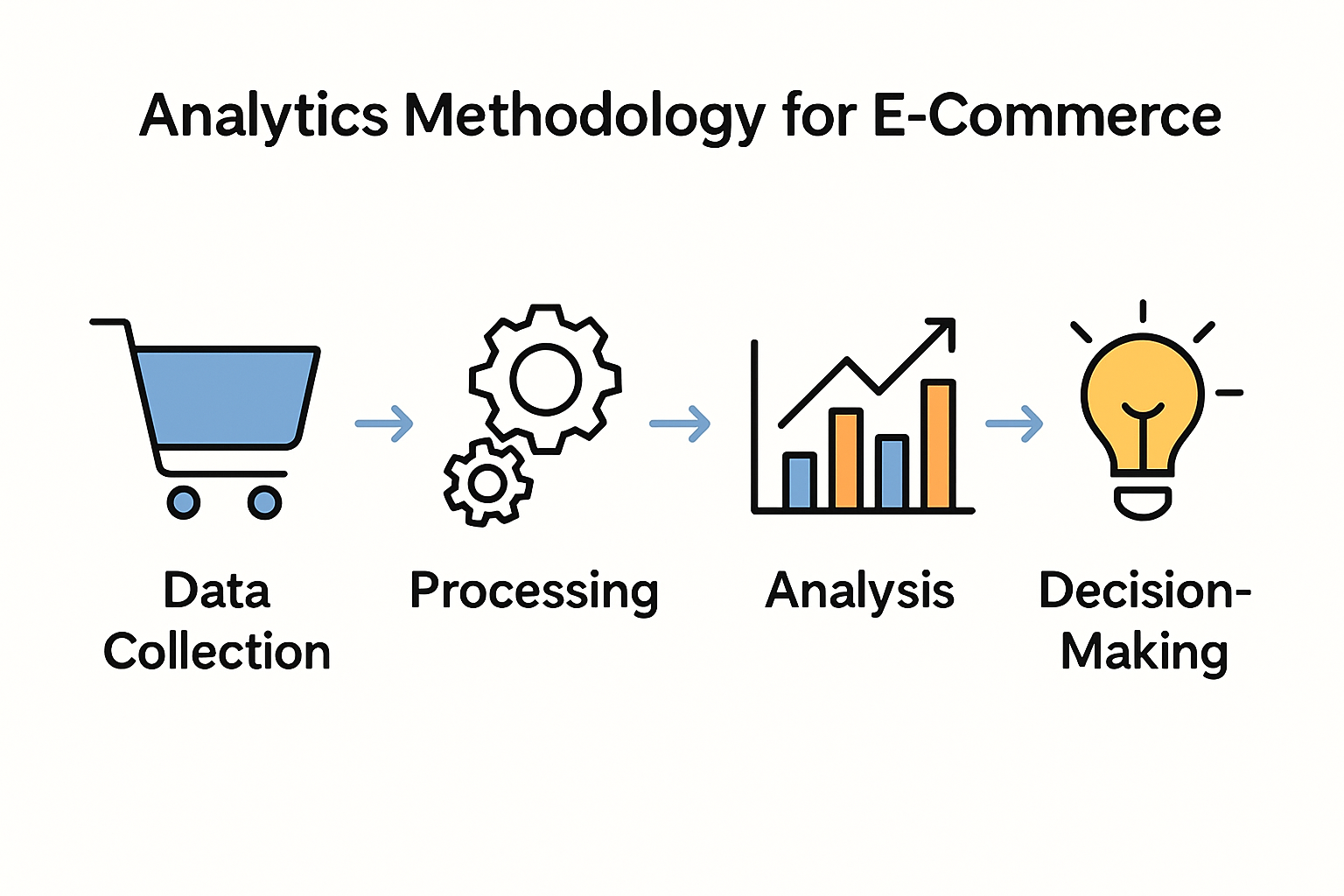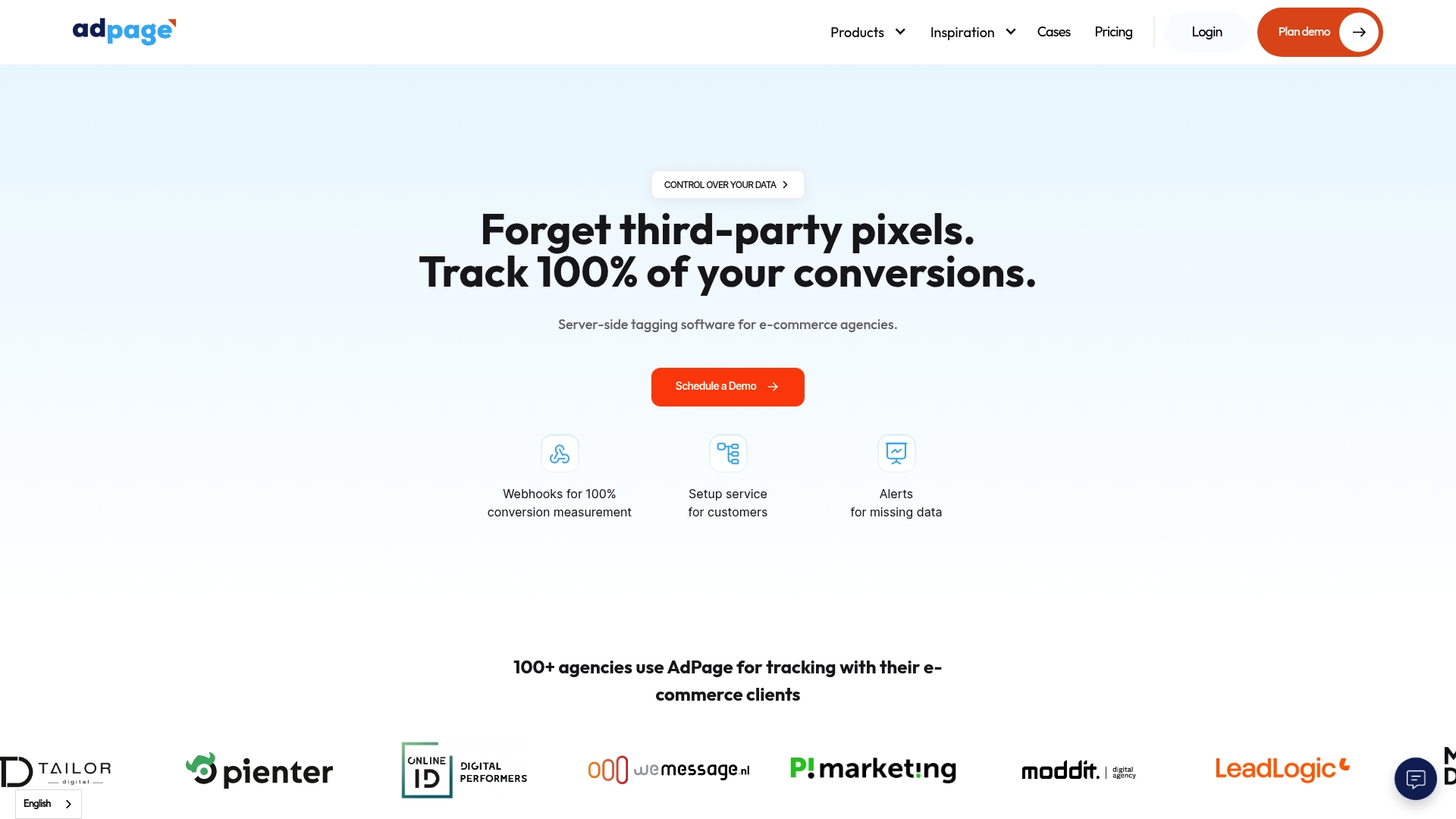Analytics methodology is shaping the future of e-commerce, turning simple website clicks into powerful business decisions. Yet, most retailers overlook the real magic happening behind the scenes. Studies show that companies using robust analytics strategies improve operational efficiency by up to 35 percent. That edge does not just come from crunching more numbers, it emerges from interpreting data in ways your competitors have not even imagined.
Table of Contents
- Understanding Analytics Methodology For Ecommerce
- Key Steps In The Analytics Methodology Process
- Choosing The Right Techniques For Better Results
- Applying Analytics Methodology To Boost Conversion Rates
Quick Summary
| Takeaway | Explanation |
|---|---|
| Integrate multiple data streams | Combining diverse data sources enhances performance insights and business strategies effectively. |
| Focus on customer segmentation | Categorizing customers by behavior improves targeting and increases engagement potential. |
| Employ predictive analytics | Anticipating customer actions can guide marketing efforts and enhance conversion rates. |
| Adopt a systematic experimentation process | Continuous testing of strategies is vital for iterative improvements and user experience optimizations. |
| Implement real-time performance monitoring | Consistent tracking allows businesses to rapidly adapt to market shifts and customer needs. |
Understanding Analytics Methodology for eCommerce
Analytics methodology in e-commerce represents a systematic approach to collecting, processing, and interpreting digital data to drive strategic business decisions. Unlike traditional retail analytics, e-commerce analytics demands precision and real-time insights that can transform raw website interactions into actionable intelligence.

Core Components of E-commerce Analytics Methodology
Successful analytics methodology goes beyond simple data collection. Research from Harvard Business Review reveals that effective methodologies integrate multiple data streams to create comprehensive performance landscapes. These components typically include:
- Data Collection Strategies: Capturing user interactions across multiple touchpoints including website visits, click paths, conversion events, and customer journey mapping.
- Statistical Processing: Transforming raw data into meaningful metrics through advanced computational techniques.
- Predictive Modeling: Using historical data to forecast future customer behaviors and potential market trends.
Professional e-commerce analysts understand that methodology is not just about gathering numbers but interpreting them with strategic precision. A comprehensive study from MIT Sloan demonstrated that businesses implementing robust analytics methodologies can increase their operational efficiency by up to 35%.
Technological Frameworks Supporting Analytics.
Modern e-commerce analytics methodologies leverage sophisticated technological frameworks designed to handle complex data ecosystems. These frameworks enable businesses to track granular details about customer interactions, purchase patterns, and engagement metrics.
Key technological considerations include:
- Server-side tracking mechanisms
- Machine learning algorithms for pattern recognition
- Real-time data processing capabilities
- Advanced segmentation tools
The goal is not merely to collect data but to transform it into strategic insights that drive meaningful business decisions. By understanding the intricate relationship between data collection, processing, and interpretation, e-commerce businesses can develop methodologies that provide genuine competitive advantages.
Implementing a robust analytics methodology requires a holistic approach that combines technical expertise, strategic thinking, and continuous adaptation to evolving digital landscapes. Businesses must remain agile, continuously refining their methodological approaches to stay ahead in the dynamic world of online commerce.
Ultimately, an effective analytics methodology serves as a powerful lens through which businesses can understand customer behavior, optimize marketing strategies, and make data-driven decisions that directly impact bottom-line performance.
Here is a summary table outlining the core components and technological frameworks of e-commerce analytics methodology, making it easier to scan their key features:
| Component/Framework | Purpose | Key Functions/Technologies |
|---|---|---|
| Data Collection Strategies | Gather data from multiple customer touchpoints | Website visits, click paths, conversion events, journey mapping |
| Statistical Processing | Convert raw data into actionable metrics | Advanced computational/statistical techniques |
| Predictive Modeling | Forecast customer behaviors and trends | Historical data analysis, behavioral forecasts |
| Server-side Tracking Mechanisms | Precise event capture and data quality | Robust tracking scripts, server logs |
| Machine Learning Algorithms | Detect patterns and predict behaviors | Clustering, classification, neural networks |
| Real-time Processing Capabilities. | Enable rapid insights and decisions | Stream processing, analytics platforms |
| Advanced Segmentation Tools | Categorize and analyze customer groups | Demographic & behavioral segmentation |
Key Steps in the Analytics Methodology Process
E-commerce analytics methodology is a structured approach that transforms raw data into strategic insights. Research from OpenStax highlights four critical stages that form the foundation of an effective analytics process, providing a comprehensive framework for digital businesses to understand and optimize their performance.
To aid understanding, the table below summarizes the key steps involved in the analytics methodology process, along with their main activities and goals:
| Step | Main Activities | Primary Goal |
|---|---|---|
| Data Collection & Preprocessing | Gather diverse data, clean, transform, standardize | Ensure precision and quality of data for analysis |
| Customer Segmentation & Analysis | Segment users by behavior, cluster, identify personas | Enable targeted strategies and predictive modeling |
| Performance Evaluation & Continuous Improvement | Assess KPIs, benchmark, refine, A/B test | Drive iterative improvements and strategy adaption |
Data Collection and Preprocessing
The initial phase of analytics methodology begins with meticulous data collection and preprocessing. Advanced research from Cornell University emphasizes the importance of gathering diverse data points including customer interactions, browsing histories, purchase records, and demographic information.
Key preprocessing techniques involve:
- Data Cleaning: Removing inaccuracies, duplicates, and irrelevant information to ensure data quality.
- Data Transformation: Normalizing and unifying data from multiple sources to facilitate comprehensive analysis.
- Standardization: Creating consistent measurement frameworks that enable accurate comparative assessments.
Professional analysts understand that quality data collection is not about volume but precision. Implementing robust server-side tracking mechanisms ensures comprehensive and accurate data capture across all digital touchpoints.

Customer Segmentation and Analysis
Customer segmentation represents a pivotal step in analytics methodology. By categorizing customers into distinct groups based on behavioral patterns, businesses can develop targeted strategies that resonate with specific audience segments.
Research from machine learning studies demonstrates that advanced clustering techniques like k-means algorithms can effectively divide customers into meaningful personas. These segmentation strategies enable:
- Personalized marketing approaches
- More efficient resource allocation
- Enhanced customer engagement strategies
- Improved predictive modeling capabilities
Successful segmentation goes beyond basic demographic categorization. It involves deep analysis of purchase behaviors, interaction patterns, and potential future actions.
Performance Evaluation and Continuous Improvement
The final critical stage of analytics methodology focuses on performance evaluation and continuous refinement. This involves developing comprehensive Key Performance Indicators (KPIs) that align directly with business objectives.
Effective performance measurement requires:
- Regular performance metric assessments
- Comparative analysis against industry benchmarks
- Iterative strategy adjustments based on insights
- Experimental approaches like A/B testing
By treating analytics as an ongoing process of discovery and adaptation, businesses can create dynamic strategies that respond quickly to changing market conditions and customer preferences.
The ultimate goal of a robust analytics methodology is not merely to collect data but to transform it into actionable intelligence that drives strategic decision-making and sustainable business growth.
Choosing the Right Techniques for Better Results
Selecting appropriate analytics techniques is crucial for transforming raw data into meaningful business insights. Research from Mathematics Journal highlights three fundamental stages of business analytics that guide technique selection: descriptive, predictive, and prescriptive approaches.
Analytical Approach Selection
E-commerce businesses must strategically choose analytical techniques that align with specific organizational objectives. A comprehensive study on model evaluation emphasizes the importance of understanding each technique's strengths and limitations.
Key considerations for technique selection include:
- Data Complexity: Matching analytical methods to the intricacy of available data
- Business Objectives: Aligning techniques with specific strategic goals
- Computational Resources: Evaluating technical infrastructure capabilities.
- Predictive Accuracy: Assessing potential performance outcomes.
Professional analysts recognize that no single technique provides a universal solution. The art of analytics lies in crafting a nuanced approach that combines multiple methodological strategies.
Advanced Analytical Techniques
Research from Web Usage Mining studies reveals sophisticated techniques for extracting deeper insights from e-commerce data. These advanced methods go beyond traditional analysis, offering more granular understanding of user behavior.
Prominent techniques include:
- Clustering algorithms for customer segmentation
- Machine learning classification models
- Predictive behavior analysis
- Neural network pattern recognition
Successful implementation requires not just technical expertise but strategic thinking. Analysts must continuously evaluate and refine their approach, understanding that analytical techniques are dynamic tools rather than static solutions.
Performance Measurement and Validation
Rigorous validation is essential when implementing new analytical techniques. This involves:
- Cross-validation of predictive models
- Continuous performance benchmarking
- Systematic error rate assessment
- Regular technique recalibration
The goal is not perfect prediction but consistent improvement. By adopting a flexible, iterative approach to technique selection, businesses can develop robust analytical frameworks that adapt to changing market dynamics.
Ultimately, choosing the right analytical techniques transforms data from a passive record into an active strategic asset. Organizations that master this approach gain significant competitive advantages, turning complex information into clear, actionable business intelligence.
Applying Analytics Methodology to Boost Conversion Rates.
Converting website visitors into customers represents the ultimate objective of e-commerce analytics methodology. Research from ResearchGate reveals that strategic application of analytics can dramatically improve conversion performance through systematic, data-driven approaches.
Predictive Behavioural Analysis
Predictive analytics provides powerful insights into potential customer actions before they occur. A comprehensive study from Northern Ireland Research demonstrates how machine learning algorithms can analyze clickstream data to identify behavioral patterns that influence purchase decisions.
Key predictive strategies include:
- Customer Journey Mapping: Tracking precise user interactions across digital touchpoints
- Behavioral Segmentation: Categorizing users based on demonstrated engagement patterns
- Purchase Probability Modeling: Calculating likelihood of conversion for specific user groups
- Friction Point Identification: Detecting potential barriers in the conversion funnel
Successful predictive analysis transforms raw data into actionable intelligence, enabling businesses to anticipate and address potential conversion obstacles proactively.
Experimental Optimization Techniques
Systematic experimentation remains crucial for conversion rate improvement. Advanced e-commerce businesses employ sophisticated testing methodologies to refine user experience continuously.
Effective experimental approaches involve:
- Simultaneous multivariate testing
- Dynamic content personalization
- Contextual user experience adaptation
- Rapid hypothesis validation
Companies like Booking.com demonstrate the power of continuous testing, running over 1,000 simultaneous experiments to incrementally enhance user engagement and conversion potential.
Performance Monitoring and Intervention
Conversion rate optimization is an ongoing process requiring constant monitoring and strategic intervention. Businesses must develop robust frameworks for:
- Real-time performance tracking
- Immediate anomaly detection
- Rapid strategic adjustment
- Continuous learning and refinement
By treating conversion optimization as a dynamic, data-driven discipline, organizations can create responsive strategies that adapt quickly to changing user behaviors and market conditions.
The ultimate goal transcends mere statistical improvement. Successful analytics methodology transforms conversion optimization from a technical exercise into a sophisticated understanding of customer psychology, enabling businesses to create increasingly compelling digital experiences that naturally guide users toward meaningful interactions.
Frequently Asked Questions
What is analytics methodology in eCommerce?
Analytics methodology in eCommerce refers to a systematic approach that involves collecting, processing, and interpreting data to inform strategic business decisions and optimize performance.
What are the core components of e-commerce analytics methodology?
The core components include data collection strategies, statistical processing, and predictive modeling, which together create a comprehensive performance landscape for businesses.
How does predictive analytics improve conversion rates in e-commerce?
Predictive analytics improves conversion rates by anticipating customer behavior, identifying potential purchase patterns, and addressing friction points in the customer journey.
What are the key steps involved in the analytics methodology process?
The key steps are data collection and preprocessing, customer segmentation and analysis, and performance evaluation, which collectively enable businesses to drive continuous improvement and strategic adaptation.
Transform Analytics Methodology into Real Results for Your Ecommerce Business
Are you struggling to turn powerful analytics insights into actual conversion improvements? The article shows how vital accurate data collection, predictive analysis, and granular customer segmentation are for e-commerce success. Yet, many marketers face the problem of data loss and unreliable conversion tracking due to outdated techniques. If you want to make every visit and click count, adopting a robust foundation for your analytics methodology is essential.

Choose smarter tracking and leave uncertainty behind. With AdPage's server-side tagging platform, you can monitor every conversion without worrying about data loss or privacy regulations. Our tools help you achieve precise, GDPR-compliant data collection and seamless integration with Shopify, WooCommerce, or Magento. Take action today to experience increased efficiency and full confidence in your analytics. Discover how you can build a future-proof strategy on the AdPage platform and claim your edge in digital commerce.



.png)
